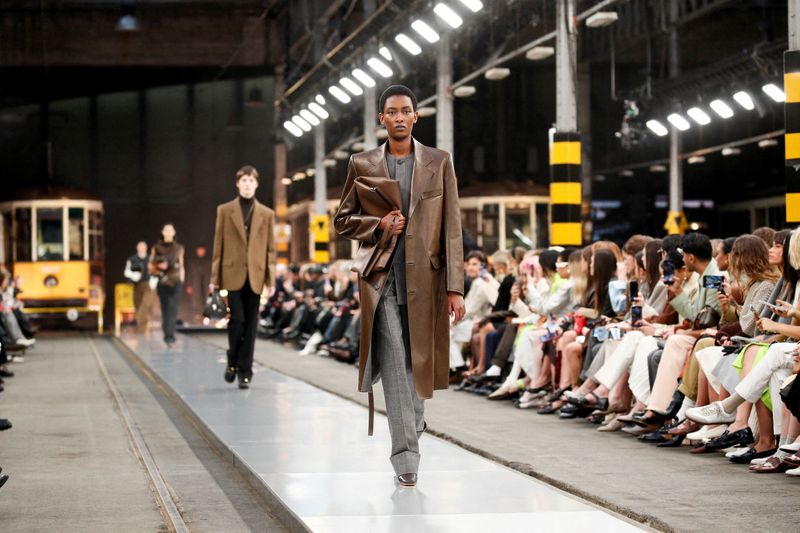Italian shoemaker Tod’s to court US lovers of quiet luxury
2024.05.07 01:30

By Elisa Anzolin and Valentina Za
MILAN (Reuters) – An investment firm backed by LVMH is betting demand from wealthy Americans for quiet luxury will ensure its 510 million euro ($545 million) stake in Italian shoemaker Tod’s yields the double-digit returns private equity typically seeks.
L Catterton, created by U.S. fund Catterton and LVMH-owner Groupe Arnault, on Friday secured sufficient shares to take Tod’s private once the deal, valuing the company at just over 1.4 billion euros ($1.5 billion), formally concludes in the coming days.
Listed in Milan but controlled by its founding Della Valle family, Tod’s profitability has lagged rivals.
Last year it postponed marketing investments to help increase its operating profit margin to 8.4% of sales – behind Prada (OTC:)’s 22.5% and Brunello Cucinelli’s 16.4%, partly because more of its production is in-house compared with peers.
Producing internally costs more than outsourcing, but gives brands greater control over quality.
L Catterton has offered 43 euros a share, deemed good value for the investment fund considering Tod’s listed at 40 euros 24 years ago when it became the first Italian luxury brand to go public.
Under the stewardship of private equity, Tod’s will invest in marketing to capitalise on its sober elegance cachet and grow U.S. sales, a person close to the matter said
Tod’s-branded shoes and handbags – including its $695 Gommino loafers, with their characteristic rubber-pellet soles – have a healthy following among well-off consumers aged 40 and above.
Further up the luxury ladder, Roger Vivier, the Paris-based $950-a-pair buckled shoe brand it acquired in 2015, appeals to Asia’s bigger spenders.
But the group’s smaller brands, such as Fay, which makes jackets inspired by U.S. workwear, and Hogan, which pioneered the luxury sneaker trend but failed to profit from its boom over the last decade, need refreshing.
A failed attempt in 2022 to take Tod’s private aimed to manage the diverse brands separately, and possibly divest the least profitable ones.
Tod’s has long refused to chase younger shoppers, a choice it appeared to partly remedy in 2021 when it named fashion influencer Chiara Ferragni to its board. After three years, her position was not renewed.
Back in 2018, Tod’s septuagenarian founder Diego Della Valle told the Financial Times that “millennials are not for everyone” – a demographic that includes people up to their early 40s.
The person close to the matter, who asked not to be named because they were not authorised to speak publicly, said the emphasis so far on older customers was one reason Tod’s had scope to increase digital sales.
Tod’s also failed to exploit fully the success of its most celebrated products, such as the $3,000 Di Bag made famous by Britain’s late Princess Diana, to drive sales by expanding more into clothing, a separate industry source said.
To compete with the best in class, Tod’s must accelerate its rollout of new collections and invest heavily in its brands’ image, the source added.
For now, Tod’s marketing and communications expenses total around 10% of sales, broadly in line with other Italian peers.
NEW CREATIVE DIRECTOR AND BIGGER FOOTPRINT
“A relaunch needs to focus on renewing and broadening the product range and … strengthening the retail channel, both brick-and-mortar stores and e-commerce”, said Giuliano Noci, strategy and marketing professor at Milan’s Politecnico University.
L Catterton’s investment plans, which have a roughly five-year time horizon typical of private equity funds, will initially erode the operating profit margin, but the delisting means the transformation can take place away from the scrutiny of short-term stock market investors.
Tod’s and L Catterton declined to be interviewed by Reuters.
In comments to Italian newspaper MF in February, Della Valle said growing its U.S. presence would be a core goal for Tod’s in the next two years, alongside developing its clothing business.
Any relaunch also requires a more ambitious retail strategy, a luxury industry executive said, with openings and a new store concept. At the end of last year, Tod’s had 19 directly-owned shops in the States, the same number as in France.
All this has to be done when luxury brands face a slowdown after a post-pandemic boom.
Demand in China is a particular cause for concern as Tod’s is strongly focused on the Asian market. The Greater China region, where Tod’s runs directly 124 boutiques, accounted for 31.7% of total sales in 2023, against the Americas’ 7.5%.
With its consumer goods focus, Connecticut-based L Catterton is well placed to drive expansion in the United States, where it aims to also grow another Italian brand, make-up maker KIKO, which it agreed to buy in April, adding to its $34 billion in assets under management.
Attempts to broaden the appeal of Tod’s are not new.
A decade ago, Tod’s tried to expand into ready-to-wear and refresh its classic elegance image, but eventually retreated to focus on the leather products that have always been central to its identity.
Clothing accounted for 6.7% of overall Tod’s sales last year, compared with around 30% at powerhouse Prada.
In December, Tod’s appointed Matteo Tamburini as its creative director for both womenswear and menswear for its main brand, but his new collections have yet to arrive in the shops.
“We go back a long way with Tod’s: quality has always been paramount to them,” said Carla Cereda Biffi, head of buying for Milan’s Biffi Boutiques, whose Corso Genova shop displays several Tod’s Bubble Ballerinas and T-bags.
“I just know that won’t change whatever they decide to do next.”








